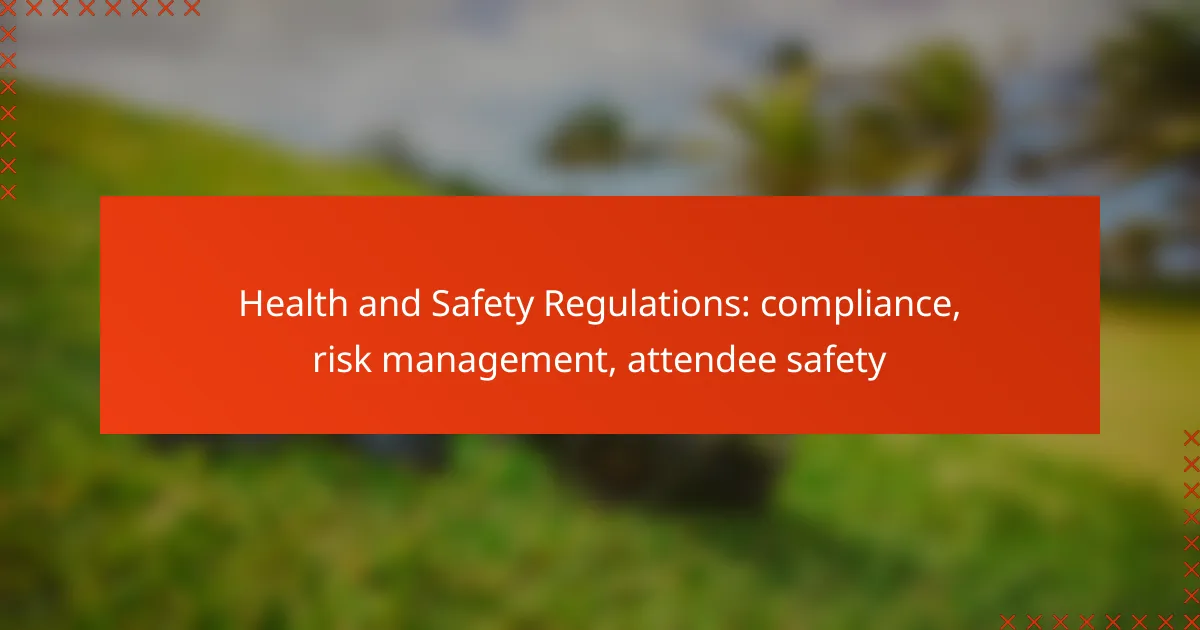Health and safety regulations are crucial for maintaining a safe environment for employees and attendees in various settings. They provide a framework for compliance and effective risk management, ensuring that organizations actively identify and mitigate potential hazards. By implementing systematic approaches, organizations can protect individuals and minimize risks associated with events and activities.

What are the key health and safety regulations in Australia?
The key health and safety regulations in Australia focus on ensuring workplace safety and minimizing risks to employees and visitors. These regulations establish frameworks for compliance, risk management, and the overall safety of attendees in various environments.
Work Health and Safety Act 2011
The Work Health and Safety Act 2011 (WHS Act) provides a comprehensive framework for workplace health and safety in Australia. It outlines the responsibilities of employers, workers, and other parties to ensure a safe working environment.
Under this Act, employers must identify hazards, assess risks, and implement control measures to mitigate those risks. Regular training and consultation with employees are essential components of compliance.
Occupational Health and Safety Regulations 2017
The Occupational Health and Safety Regulations 2017 complement the WHS Act by detailing specific requirements for various industries. These regulations cover areas such as risk assessment, emergency procedures, and the use of personal protective equipment (PPE).
Employers must ensure that all safety measures are documented and that employees are trained in safe work practices. Regular audits and inspections can help maintain compliance and improve safety standards.
Safe Work Australia guidelines
Safe Work Australia provides guidelines that support the implementation of the WHS Act and the Occupational Health and Safety Regulations. These guidelines offer practical advice on managing risks and promoting health and safety in the workplace.
Employers can utilize these resources to develop safety management systems tailored to their specific operations. Regular updates and revisions to these guidelines ensure that they reflect current best practices and legal requirements.

How to ensure compliance with health and safety regulations?
Ensuring compliance with health and safety regulations involves understanding the applicable laws and actively managing risks to protect employees and attendees. Organizations must implement systematic approaches to identify hazards, assess risks, and maintain a safe environment.
Conduct regular risk assessments
Regular risk assessments are essential for identifying potential hazards in the workplace. These assessments should be conducted at least annually or whenever there are significant changes in operations or personnel. The process involves evaluating the likelihood of incidents and the severity of their consequences.
Utilize a structured approach, such as the five-step risk assessment process: identify hazards, decide who might be harmed and how, evaluate the risks and decide on precautions, record your findings, and review your assessment regularly. This helps ensure that all potential risks are addressed effectively.
Implement safety management systems
Safety management systems (SMS) provide a framework for managing safety risks and ensuring compliance with regulations. An effective SMS includes policies, procedures, and practices that promote a culture of safety within the organization. It should be tailored to the specific needs and risks associated with the workplace.
Key components of an SMS include clear safety objectives, regular monitoring and evaluation of safety performance, and continuous improvement processes. Consider using software tools to streamline reporting and tracking of safety incidents and compliance metrics.
Provide employee training programs
Employee training programs are vital for ensuring that staff understand safety protocols and their roles in maintaining a safe environment. Training should cover topics such as hazard recognition, emergency procedures, and the proper use of personal protective equipment (PPE).
Training should be ongoing and updated regularly to reflect changes in regulations or workplace conditions. Consider using a mix of training methods, including hands-on demonstrations, e-learning modules, and safety drills, to engage employees effectively and reinforce learning.

What are effective risk management strategies?
Effective risk management strategies involve identifying, evaluating, and controlling potential hazards to ensure attendee safety. These strategies are essential for compliance with health and safety regulations and help organizations minimize risks associated with events or activities.
Identify potential hazards
Identifying potential hazards is the first step in effective risk management. This process involves recognizing anything that could cause harm, such as physical, chemical, biological, or ergonomic risks. Conducting thorough inspections and engaging with staff and attendees can help uncover less obvious hazards.
Common methods for identifying hazards include site assessments, reviewing incident reports, and consulting safety guidelines relevant to your locale. For example, in the United States, OSHA provides resources to help organizations identify workplace hazards.
Evaluate risks and implement controls
Once hazards are identified, the next step is to evaluate the associated risks and implement appropriate controls. This involves assessing the likelihood and severity of potential incidents and determining which risks are acceptable. Risk evaluation can be qualitative or quantitative, depending on the context.
Implementing controls may include engineering solutions, administrative changes, or personal protective equipment. For instance, if a venue has a high risk of slips and falls, installing non-slip flooring and providing clear signage can significantly reduce incidents.
Monitor and review risk management practices
Monitoring and reviewing risk management practices is crucial for maintaining safety standards. Regular audits and feedback from attendees and staff can help identify areas for improvement. Establishing a routine schedule for reviews ensures that risk management strategies remain effective and compliant with regulations.
Additionally, keeping records of incidents and near misses can provide valuable insights into the effectiveness of current practices. This data can inform future risk assessments and help refine strategies, ensuring ongoing attendee safety and compliance with health and safety regulations.

How to enhance attendee safety at events?
Enhancing attendee safety at events involves proactive planning, effective communication, and thorough risk management. By implementing comprehensive safety measures, organizers can significantly reduce risks and ensure a secure environment for all participants.
Develop an event safety plan
A well-structured event safety plan outlines the protocols and procedures necessary to manage potential risks. This plan should include a detailed assessment of the venue, identifying hazards, and outlining safety measures tailored to the specific event type.
Key components of the safety plan include emergency contact information, evacuation routes, and designated safety personnel. Regular training sessions for staff on these protocols can enhance preparedness and response times during emergencies.
Ensure emergency response procedures are in place
Establishing clear emergency response procedures is crucial for attendee safety. These procedures should detail actions to take in various scenarios, such as medical emergencies, fire, or natural disasters.
It is advisable to conduct drills before the event to familiarize staff and volunteers with these procedures. Additionally, having first aid kits and trained medical personnel on-site can provide immediate assistance when needed.
Utilize crowd management techniques
Effective crowd management techniques help maintain order and safety during events. This includes strategic layout planning, clear signage, and trained personnel to guide attendees and manage queues.
Consider using barriers to direct foot traffic and prevent overcrowding in specific areas. Monitoring crowd density can help identify potential issues before they escalate, ensuring a safer experience for everyone involved.

What are the penalties for non-compliance?
Penalties for non-compliance with health and safety regulations can include fines, legal consequences, and damage to a business’s reputation. These repercussions vary depending on the severity of the violation and the jurisdiction in which the business operates.
Fines and legal repercussions
Fines for non-compliance can range from hundreds to thousands of dollars, depending on the nature of the violation and local laws. In some cases, repeated offenses may lead to significantly higher penalties or even criminal charges against responsible individuals.
Legal repercussions can include lawsuits from affected parties, which may result in additional financial liabilities. Businesses should be aware of the specific regulations in their area to avoid costly legal battles.
Reputational damage for businesses
Non-compliance can severely damage a business’s reputation, leading to loss of customer trust and loyalty. Negative publicity from safety violations can deter potential clients and partners, impacting long-term profitability.
Rebuilding a tarnished reputation can take considerable time and resources, often requiring businesses to invest in public relations campaigns and enhanced safety measures to regain public confidence.
Increased insurance premiums
Insurance companies often raise premiums for businesses that have a history of non-compliance with health and safety regulations. This increase can range from modest to significant, depending on the frequency and severity of past incidents.
To mitigate rising costs, businesses should proactively address compliance issues and demonstrate a commitment to safety. Regular audits and training can help maintain lower insurance rates and improve overall risk management.



